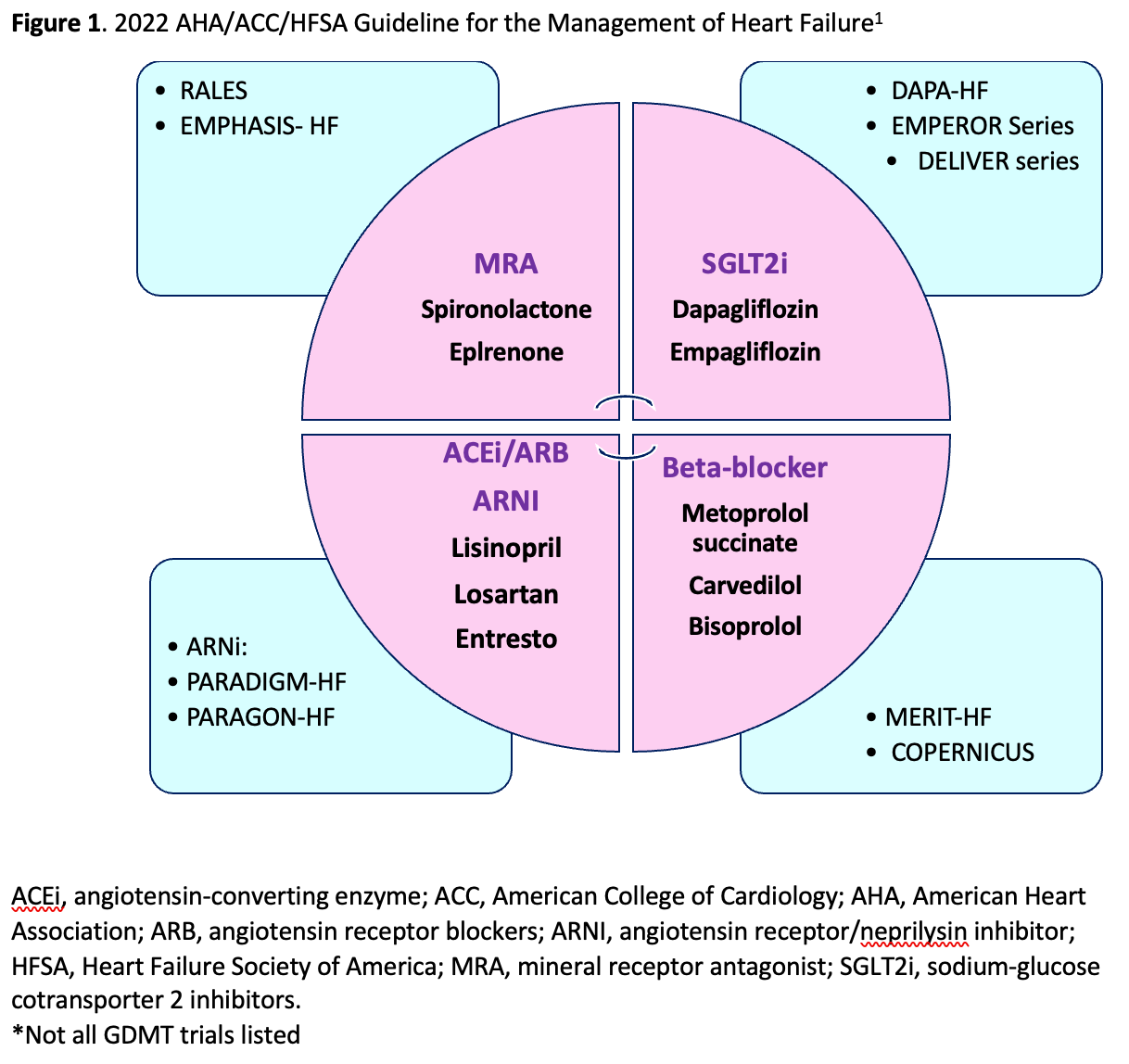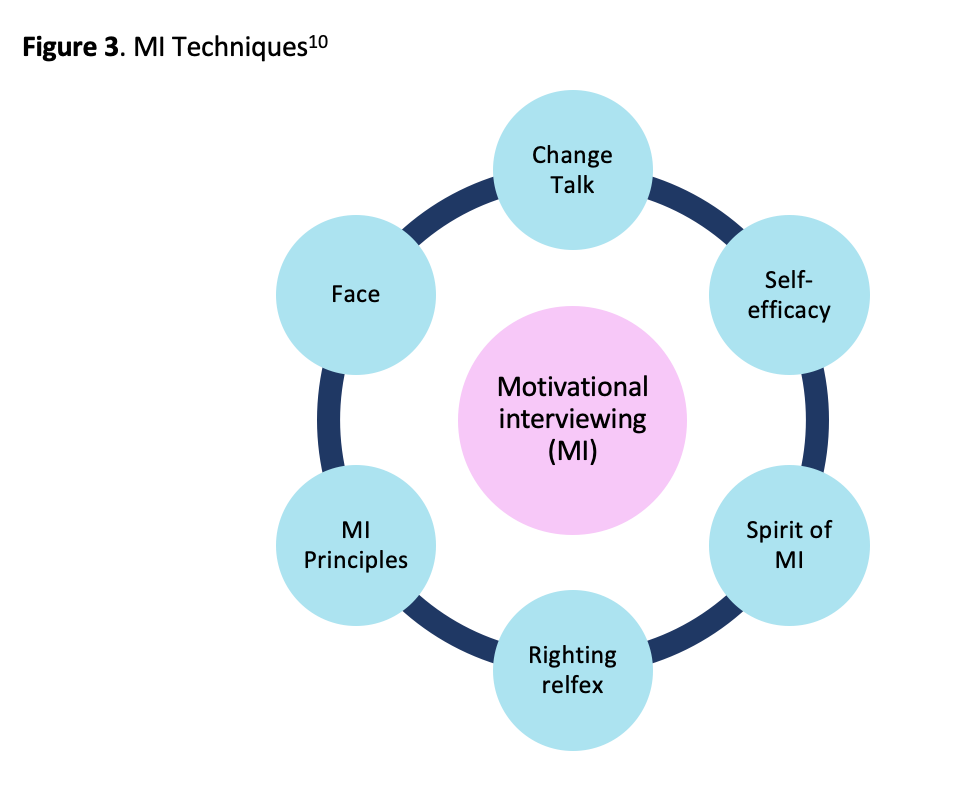Feature
Article
Let’s Have a Heart to Heart About Heart Failure
Author(s):
Initiating and optimizing heart failure guideline-directed medical therapy is critical to the comprehensive management of heart failure.
Heart failure is a complex disease involving an impairment in the ventricular ejection or filling of blood in the heart.1 One common cause of heart failure is structural heart impairment, which can be caused by genetics, valvular heart disease, or acute myocardial injury.1 Two of the most common types of heart failure are heart failure with preserved ejection fraction (HFpEF) and heart failure with reduced ejection fraction (HFrEF). HFpEF occurs when the left ventricular ejection fraction (LVEF) is 50% or greater and there is an impairment in ventricular diastolic filling and relaxation. HFrEF occurs when the LVEF is 40% or less, and there is an impairment in the ventricular pumping of blood.
In the United States, heart failure hospitalizations represent a significant challenge within health care. In 2017, there were 924,000 patients with heart failure in the United States, comprising 1.2 million heart failure hospitalizations in that year.1 In 2022, heart failure-related medical expenses were estimated to be $39.2 billion to $60 billion.2 Heart failure also comprises a high mortality rate of 45%-60% over 5 years.3 As a result, major federal agencies, such as the Centers for Medicare and Medicaid Services, persistently encourage health care institutions to participate in initiatives to reduce overall heart failure hospitalizations and mortality.
In efforts to optimize medical therapies to improve patient outcomes, several landmark trials have emerged in the last decades to set the standards for guideline-directed medical therapy (GDMT). These standards aim to improve patients' quality of life by reducing morbidity and mortality rates (Figure 1). Ideally, GDMT medication should be up-titrated to maximum dose if tolerated to reduce hospitalizations and mortality.4 In 2022, the Strong-HF trial (NCT03412201), a multinational, randomized prospective study, suggested that GDMT initiation and rapid titration with close follow-ups after acute hospitalizations were linked to reduced heart failure symptoms, improved quality of life, and reduced 30-day readmission rates.4 In a cross-trial analysis by Vaduganathan et al, the initiation of multiple GDMT agents in patients 65 years or older was linked to an increase of 4.4 years in the patients’ lifespan.5 Therefore, initiating and optimizing heart failure GDMT is critical to patients’ comprehensive management of heart failure.

Optimizing patients on GDMT, nevertheless, does not come without its barriers. The 2018 CHAMP-HF (Change the Management of Patients with Heart Failure) registry, a prospective, observational study on the use of GDMT in HFrEF patients, showed that prescription rates for GDMT medications differed significantly among specialties.6 Providers practicing in family medicine clinics prescribed beta-blockers at a rate of 42.3% compared to 70.5% for providers in a cardiology-focused practice.6,7 Some attributable barriers to these discrepancies in GDMT prescribing were associated with advanced age, hypotension, high New York Heart Association class, electrolyte imbalances, and poor renal function.7 In a systematic review by Malgie et al, hyperkalemia was shown to be a key reason for not achieving a target dose of an MRA in 10.4% of patients.6 The patients' socioeconomic status has also been shown to significantly impact GDMT prescribing. In a study by Mentias et al, rural areas had significantly lower prescribing of GDMT than urban areas.8 As we navigate barriers to GDMT medication, it is essential to consider patient-centered factors and explore individual dynamics that influence treatment adherence and overall health care outcomes.
As we navigate barriers to GDMT medication, it is essential to consider patient-centered factors and explore individual dynamics that influence treatment adherence and overall health care outcomes. Image Credit: © lovelyday12 - stock.adobe.com

The initiation and optimization of GDMT therapies are often underutilized due to patient-centered barriers and willingness to comply with the prescribed regimen (Figure 2). Medication non-adherence has remained a persistent problem in health care over the decades. Approximately 50% of patients with chronic illnesses are reported to be non-adherent.9 Some patient-centered barriers to medication non-adherence include ambivalent attitude, medication cost, inconsistent assistance with daily living activities, and comorbidities restrictions. A single-institution study by Burgess et al found that prevalent causes of patient non-adherence included 71% misunderstanding their regimen, 62% facing cost-related challenges, and 57% contributing to polypharmacy.10 As patient-centered medication barriers are further explored, the pivotal role of pharmacists comes to the forefront, to address and navigate these obstacles to ensure a more personalized and practical health care experience.

Pharmacists play a critical role in addressing medication adherence barriers. A valuable tool to address these barriers is motivational interviewing (MI). MI is a counseling tool defined as “a collaborative, person-centered form of guiding to elicit and strengthen motivation for change.”11 Developed in the 1980s by clinical psychologists William R. Miller and Stephen Rollnick, motivational interviewing was initially designed to assist patients dealing with substance abuse disorders.12 Over time, its application has expanded to address a diverse range of issues, including treatment of diabetes, asthma, smoking cessation, and heart failure.12 This tool gauges a patient’s autonomy and facilitates confidence in decision-making. Motivational interviewing helps overcome ambivalence, introduce self-motivation, actively incorporate patients into their medication management, and proactively prepare patients to face potential medication challenges.
Motivational interviewing comprises several components that guide health care professionals in effectively engaging patients to achieve positive health outcomes (Figure 3 and Figure 4). In one study by Abughosh et al examining the effects of telephone motivational interviewing to improve medication adherence, data showed that patients who received the initial motivational interviewing and participated in 2 or more follow-up calls had fewer medication discontinuation rates and better adherence during the 6-month post-intervention period.13


Pharmacists play an essential role in reducing heart failure hospital readmission rates by promoting medication education and medication adherence. In a systematic review by Poudel et al evaluating the impact of motivational interviewing in heart failure patients, data showed a positive effect on patient self-care behavior, such as increased exercise activities, as well as an improvement in quality of life.14 Although quality of life components may seem subjective, they serve as a meaningful measure, offering insight into a patient’s perceptions of the disease's impact on their daily lives.15 This assessment parameter may significantly influence the patient’s motivation and commitment to improve adherence.
At the core of motivational interviewing are 2 crucial factors: the demonstration of empathy and the strategic use of open-ended questions.10 This promotes a comprehensive understanding and awareness of medications the patient is currently taking. For patients with heart failure, it is valuable to encourage them to complete daily weights and monitor any worsening of breathing reinforces the patient’s autonomy. This better promotes patient outcomes as they are actively monitoring for heart failure exacerbation symptoms. Educating patients on potential medication challenges can further help with medication adherence. For instance, patients taking beta blockers and ARNIs can benefit from an action plan to address potential hypotension or bradycardia, enabling proactive communication with health care providers for any necessary medication dose adjustments. Another impact of the pharmacist is assisting patients with medication access and educating patients on potential scenarios regarding medication costs, such as insurance deductibles and medication assistance programs from manufacturers. This prevents any abrupt discontinuation of the medication, fosters an understanding of the benefits of the medication, promotes readiness to address potential challenges, and cultivates awareness that their providers and pharmacists can work with them to set up a more personalized heart failure regimen.
Pharmacists must embrace the role of patient advocates, striving to enhance health outcomes by compassionately addressing barriers to adherence. Initiating and optimizing heart failure GDMT comes with multiple challenges, from patient medical factors to patients’ engagement in their care. By ensuring accessibility and fostering a supportive environment, pharmacists can empower patients to adhere to their medications, promoting their overall well-being with the utmost care and professionalism.
References
- Heidenreich PA, Bozkurt B, Aguilar D, et al. 2022 AHA/ACC/HFSA Guideline for the Management of Heart Failure: A Report of the American College of Cardiology/American Heart Association Joint Committee on Clinical Practice Guidelines. Circulation. 2022;145(18):e895-e1032. doi:10.1161/CIR.0000000000001063
- Heidenreich PA, Fonarow GC, Opsha Y, et al. Economic Issues in Heart Failure in the United States. J Card Fail. 2022;28(3):453-466. doi:10.1016/j.cardfail.2021.12.017
- Bytyçi I, Bajraktari G. Mortality in heart failure patients. Anatol J Cardiol. 2015;15(1):63-68. doi:10.5152/akd.2014.5731
- Mebazaa A, Davison B, Chioncel O, et al. Safety, tolerability, and efficacy of up-titration of guideline-directed medical therapies for acute heart failure (STRONG-HF): a multinational, open-label, randomized trial. Lancet. 2022;400(10367):1938-1952. doi:10.1016/S0140-6736(22)02076-1
- Vaduganathan M, Claggett BL, Jhund PS, et al. Estimating lifetime benefits of comprehensive disease-modifying pharmacological therapies in patients with heart failure with reduced ejection fraction: a comparative analysis of three randomized controlled trials. Lancet. 2020;396(10244):121-128. doi:10.1016/S0140-6736(20)30748-0
- Greene SJ, Butler J, Albert NM, et al. Medical Therapy for Heart Failure With Reduced Ejection Fraction: The CHAMP-HF Registry. J Am Coll Cardiol. 2018;72(4):351-366. doi:10.1016/j.jacc.2018.04.070
- Malgie J, Clephas PRD, Brunner-La Rocca HP, de Boer RA, Brugts JJ. Guideline-directed medical therapy for HFrEF: sequencing strategies and barriers for life-saving drug therapy. Heart Fail Rev. 2023;28(5):1221-1234. doi:10.1007/s10741-023-10325-2
- Mentias A, Keshvani N, Sumarsono A, et al. Patterns, Prognostic Implications, and Rural-Urban Disparities in Optimal GDMT Following HFrEF Diagnosis Among Medicare Beneficiaries. JACC Heart Fail. 2023:S2213-1779(23)00597-8. doi:10.1016/j.jchf.2023.08.027
- Brown MT, Bussell JK. Medication adherence: WHO cares? Mayo Clin Proc. 2011;86(4):304-314. doi:10.4065/mcp.2010.0575
- Burgess K., et al. Abstract 217: Assessing Medication Non-Adherence In Heart Failure Patients: A Resident Driven Quality Improvement Initiative. Circulation. 2022;15:A217.doi:10.1161/circoutcomes.15.suppl_1.217
- Kavookjian J. Motivational interviewing. American College of Clinical Pharmacy. Accessed February 16, 2024. https://www.accp.com/docs/bookstore/psap/p7b08.sample01.pdf
- Rubak S, Sandbæk A, Lauritzen T, Christensen Bo. Motivational interviewing: a systematic review and meta-analysis. Br J Gen Pract. 2005;55(513):305-312.
- Abughosh S, Wang X, Serna O, et al. A Motivational Interviewing Intervention by Pharmacy Students to Improve Medication Adherence. J Manag Care Spec Pharm. 2017;23(5):549-560. doi:10.18553/jmcp.2017.23.5.549
- Poudel N, Kavookjian J, Scalese MJ. Motivational Interviewing as a Strategy to Impact Outcomes in Heart Failure Patients: A Systematic Review. Patient. 2020;13(1):43-55. doi:10.1007/s40271-019-00387-6
- Heo S, Lennie TA, Okoli C, Moser DK. Quality of life in patients with heart failure: ask the patients. Heart Lung. 2009;38(2):100-108. doi:10.1016/j.hrtlng.2008.04.002
Newsletter
Stay informed on drug updates, treatment guidelines, and pharmacy practice trends—subscribe to Pharmacy Times for weekly clinical insights.






